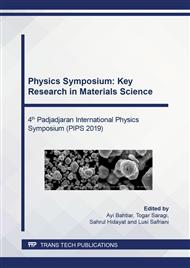[1]
M.A. Green, Y. Hishikawa, W. Warta, E.D. Dunlop, D.H. Levi, J. Hohl-Ebinger, A.W.H. Ho-Baillie, Solar cell efficiency tables (version 50), Prog. Photovolt. 25 (2017) 668–676.
DOI: 10.1002/pip.2909
Google Scholar
[2]
J.A. Luceno-Sanchez, A.M. Diez-Pascual and R. P. Capilla, Materials for Photovoltaics: State of Art and Recent Developments, Int. J. Mol. Sci. 20(4) (2019) 976.
Google Scholar
[3]
A. Goetzberger, C. Hebling, H.W. Schock, Photovoltaic materials, history, status and outlook, Mater. Sci. Eng.: R: Reports 40 (2003) 1–46.
DOI: 10.1016/s0927-796x(02)00092-x
Google Scholar
[4]
D.E. Carlson, C.R. Wronski, Amorphous silicon solar cell, Appl. Phys. Lett. 28 (1976) 671–673.
DOI: 10.1063/1.88617
Google Scholar
[5]
L.L. Kazmerski, F.R. White, G.K. Morgan, Thin‐film CuInSe2/CdS heterojunction solar cells, Appl. Phys. Lett. 29 (1976) 268–270.
DOI: 10.1063/1.89041
Google Scholar
[6]
A. Mahmood, Recent research progress on quasi-solid-state electrolytes for dye-sensitized solar cells, J. Energy Chem. 24 (2015) 686–692.
DOI: 10.1016/j.jechem.2015.10.018
Google Scholar
[7]
B. O'Regan, M. Gratzel, A low-cost, high-efficiency solar cell based on dye-sensitized colloidal TiO2, Nature 353 (6346) (1991) 737–740.
DOI: 10.1038/353737a0
Google Scholar
[8]
F. Bella, C. Gerbaldi, C. Barolo, M. Gratzel, Aqueous dye-sensitized solar cells, Chem. Soc. Rev. 44 (11) (2015) 3431–3473.
DOI: 10.1039/c4cs00456f
Google Scholar
[9]
I.N. Obotowo, I.B. Obot and U.J. Ekpe, Organic sensitizers for dye-sensitized solar cell (DSSC): Properties from computation, progress and future perspectives J. Mol. Struct. 1122 (2016) 80.
DOI: 10.1016/j.molstruc.2016.05.080
Google Scholar
[10]
X.L. Fang, M.Y. Li, K.M. Guo, Y.D. Zhu, Z.Q. Hu, X.L. Liu, B.L. Chen, X.Z. Zhao, Improved properties of dye-sensitized solar cells by incorporation of graphene into the photoelectrodes, Electrochem. Acta 65 (2012) 174–178.
DOI: 10.1016/j.electacta.2012.01.038
Google Scholar
[11]
B. Tang, G.X. Hu, Two kinds of graphene-based composites for photoanode applying in dye-sensitized solar cell, J. Power Sources 220 (2012) 95–102.
DOI: 10.1016/j.jpowsour.2012.07.093
Google Scholar
[12]
T. Chen, W. Hu, J. Song, G.H. Guai, C.M. Li, Interface Functionalization of Photoelectrodes with Graphene for High Performance Dye-Sensitized Solar Cells, Adv. Funct. Mater. 22 (2012) 5245-5250.
DOI: 10.1002/adfm.201201126
Google Scholar
[13]
D.S.U. Peiris, P. Ekanayake, M. I. Petra, Stacked rGO–TiO2 photoanode via electrophoretic deposition for highly efficient dye-sensitized solar cells, Org. Electron. 59 (2018) 399–405.
DOI: 10.1016/j.orgel.2018.05.059
Google Scholar
[14]
R. Ramamoorthy, V. Eswaramoorthi, M. Sundararajan, M. Boobalan, A.D. Sivagami, R.V. Williams, Reduced graphene oxide modified titania photoanodes for fabrication of the efficient dye‐sensitized solar cell, J. Mater. Sci.: Mater. Electron 30 (2019) 12966–12980.
DOI: 10.1007/s10854-019-01659-5
Google Scholar
[15]
K.A. Kumar, K. Subalakshmi, J. Senthilselvan, Effect of co-sensitization in solar exfoliated TiO2 functionalized rGO photoanode for dye-sensitized solar cell applications, Mat. Sci. Semicon. Proc. 96 (2019) 104–115.
DOI: 10.1016/j.mssp.2019.02.027
Google Scholar
[16]
A. Al Nafiey, A. Addad, B. Sieber, G. Chastanet, A. Barras, S. Szunerits, R. Boukherroub, Reduced graphene oxide decorated with Co3O4 nanoparticles (rGO-Co3O4) nanocomposite: A reusable catalyst for highly efficient reduction of 4-nitrophenol, and Cr(VI) and dye removal from aqueous solutions, Chem. Eng. J. 322 (2017) 375–384.
DOI: 10.1016/j.cej.2017.04.039
Google Scholar
[17]
Fitrilawati, N. Syakir, A. Aprilia, Z. Liu, X. Feng and C. Bubeck, Reduction Kinetics of Thermally Reduced Graphene Oxide Thin Films, Mater. Sci. Forum 827 (2015) 317-320.
DOI: 10.4028/www.scientific.net/msf.827.317
Google Scholar
[18]
Abid, P. Sehrawat, S. S. Islam, P. Mishra, S. Ahmad, Reduced graphene oxide (rGO) based wideband optical sensor and the role of temperature, defect states and quantum efficiency, Sci. Rep. 8 (2018) 8, 3537.
DOI: 10.1038/s41598-018-21686-2
Google Scholar
[19]
Y. Hu, H. Ma, W. Liu, Q. Lin, B. Liu, Preparation and investigation of microtribological properties of graphene oxide and graphene films via electrostatic layer-by-layer self-assembly, J. Nanomater. 2015 (2015) 282369.
DOI: 10.1155/2015/282369
Google Scholar


